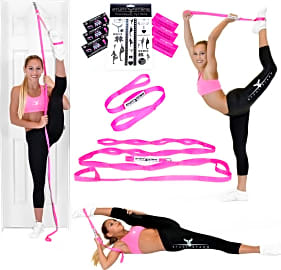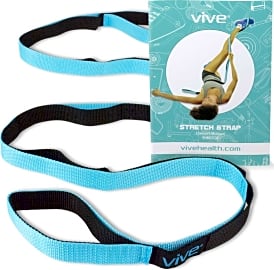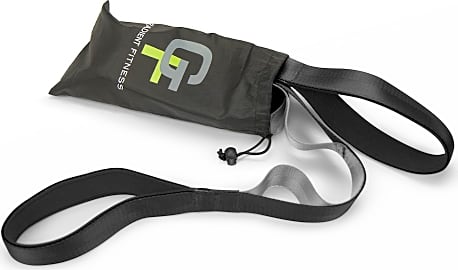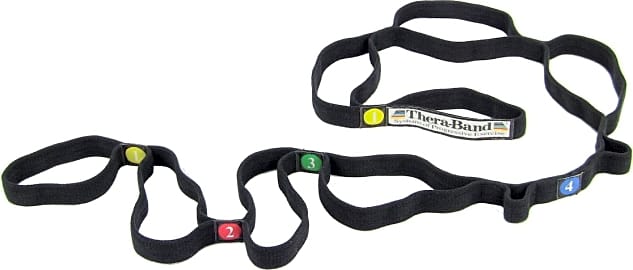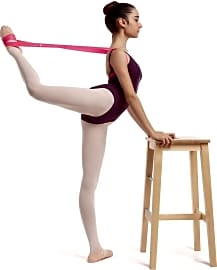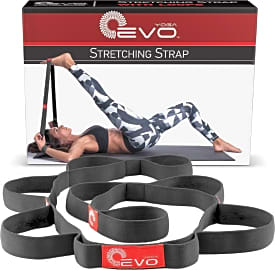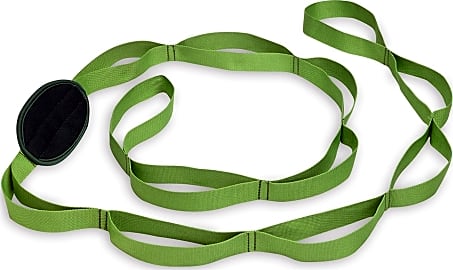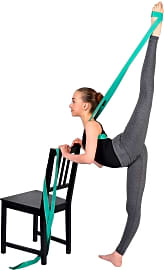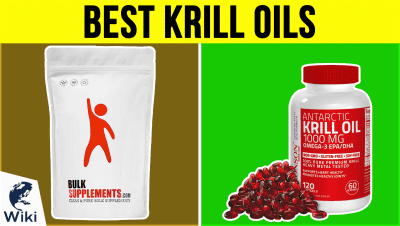The 9 Best Flexibility Straps

This wiki has been updated 39 times since it was first published in October of 2015. Whether you’re a dancer, a gymnast, a yogi, an athlete, or simply someone hoping to stay limber as you get older, you can benefit greatly from adopting a regular stretching routine. The flexibility straps and bands we've compiled here are among the highest quality options available on the market, and are all made from materials that will facilitate their ease of use and ensure their longevity. When users buy our independently chosen editorial recommendations, we may earn commissions to help fund the Wiki.
Editor's Notes
June 11, 2021:
With no recent advancements in the category, our only adjustment here was to remove a generic model that's no longer available. In the meantime, the OPTP Stretch Out remains one of the most popular choices, while the Thera-Band Strap is similarly effective and uses color coding to eliminate all doubt during use. If you prefer a strap without loops, the Superior Stretch Band is a good choice, although it does have a noticeable break-in period.
March 26, 2020:
These flexibility straps are great for performing stretches to increase agility and strengthen the muscles. They’re commonly used by dancers, gymnasts, and cheerleaders, as well as those going through physical therapy treatments. They’re offered in a variety of materials and designs, as our list reflects. In this update, we added in the Vive Stretch Belt, an extra-long option that helps facilitate a gentle full-body stretch. It’s great for yoga, Pilates, ballet, and more, as it offers 10 shoe-sized loops that accommodate most athletic shoes. You can choose the right one based on a given pose and your level of flexibility. It’s made of sturdy nylon to withstand extensive use. You can purchase it with confidence, since it’s backed by a 60-day money-back guarantee.
For a tried-and-true model that’s been sold for more than 20 years and is commonly recommended by physical therapists and athletic trainers, look to the OPTP Stretch Out. It’s made of comfortable nylon with a durable woven construction and measures more than six feet in length. It’s constructed with 10 foot and hand loops, and comes with a booklet that outlines more than 30 effective exercises you can perform using it.
If you’d rather not deal with loops, look to a model like the Superior Stretch Band, which is a single, straight piece of natural rubber that can be stretched around your limbs and arms as needed to perform stretches and splits. It’s well suited for resistance training and is a popular choice among dancers and cheerleaders. Speaking of which, anyone who’s on the road a lot for sports competitions will need to take their workouts with them, and the Stunt Stand Strap is designed to attach to any door to assist you with your leg stretches. It’s designed to help improve your leg flexibility, balance, and range of motion.
No matter which model you’re interested in, be sure to consult with your doctor to make sure this type of equipment is safe and appropriate for you. Another option to talk with your doctor about might be exercise bands, which also are good for strengthening the muscles of the arms and legs. They often come in a multi-pack, with each conveniently color-coded to show different levels of resistance.
The Importance of Staying Flexible
Then again, if you can't get out of your chair in your old age, it gives you an excuse to let someone else chase those grandkids around all day.
When you're thinking about muscles, bulk and definition get all the press. Everyone wants to be huge and ripped, but rarely do you hear about the importance of staying flexible.
Well, you're about to hear a lot about the importance of staying flexible.
Being limber can help prevent injury, especially chronic pain. When your muscles tense up, they pull on your skeletal structure, which can throw things out of alignment. For example, since many people spend all day sitting down at their desk nowadays, this causes the hamstrings and hip flexors to tighten, which pulls on the pelvis and lower back. Over time, this can cause chronic lower back pain, which is an extremely common health complaint.
Flexibility contributes to mobility as well. Compressed muscles prevent your joints from being able to reach their full range of motion, and the longer this is allowed to go on, the more likely it is that the inhibited motion will become permanent.
There can even be an increased risk of early death tied to being inflexible. It's potentially linked to a higher likelihood of cardiovascular disease, as poor pliability can also create hardening of the arteries. Stretching also lowers blood pressure, which further improves heart health.
If you're the athletic type, having pliant muscles can reduce the risk of injury. It boosts the flow of blood to the muscles, increasing the amount of oxygen and nutrients in the tissue. That could potentially improve your performance as well, although the jury is still out on that.
Regardless of whether stretching takes a second or two off your 40-yard dash time, being flexible is an important aspect of overall health and wellness. It's definitely worth taking a few minutes out of your day to work on your pliability, especially if you care about being able to move around freely later in life.
Then again, if you can't get out of your chair in your old age, it gives you an excuse to let someone else chase those grandkids around all day.
How to Use Flexibility Straps
Sometimes, if you really want to get deep into that stretch, you need a little help — and that's where flexibility straps come in.
Flexibility straps are stretchy bands, usually made out of rubber, that enable the user to pull their muscles further than they'd ordinarily be able to push them on their own. It's like having a partner that helps deepen your stretches, except without having to smell another person's body odor. If you've never used one before, here are a few tips for getting the best stretch of your life.
If you like doing static stretching, these bands are ideal for that. That's when you put yourself in a stretch and hold it for a set period of time.
If you like doing static stretching, these bands are ideal for that.
For example, if you're trying to get a deeper extension on your hamstrings, a good way to do that is by laying flat on the floor, then grabbing each end of the strap and looping the middle around your heel. Gently pull your foot towards you while keeping your leg straight. You should feel this all the way down the back of your leg. Try to deepen the stretch a little more each time you do it.
There's another kind of flexibility training, called ballistic stretching, that can also benefit from use of flexibility straps. This involves bouncing and rocking while stretching, and then using the momentum to push yourself further.
One way to do this is, when targeting your sides, stand up straight and hold the strap in the same way. Lean over to one side, and use the arm on that side to put pressure on the strap. This should bring your entire body over to the side being stretched. You can then use your other arm to pull you over to the other side. At the end of each stretch, you can add a little spring to deepen the extension.
No matter how you prefer to stretch — or if you want to incorporate both kinds into your workouts — having a strap can help push you beyond your natural limitations.
Or, if you don't like stretching at all, you can use them as massive slingshots.
Other Ways to Stay Limber
While consistent and regular stretching is the best way to keep your body flexible, it's not the only way. Below are some other simple ways to stay pliable, regardless of your age or activity level.
Maintaining correct posture is one of the most important things you can do. Even if you're stuck at your desk all day, holding your back and neck in the proper alignment can help nip problems in the bud. Don't slouch, and keep your shoulders from rounding.
With just a little bit of effort, you should be able to keep your body in peak condition — even if it's just so you can spend more time behind your desk.
This is much easier if you have proper ergonomics. Make sure your computer monitor is even with your eye line, so that you don't have to crane your neck to see those spreadsheets. Invest in a good office chair, or even try sitting on a yoga ball, which forces you to activate your core while you work.
Regardless of how comfortable your furniture is, though, you shouldn't sit in it all day. Practice the 50-10 rule, which says that for every fifty minutes you spend sitting, you should devote ten to getting up and walking around. This helps get your muscles working, as well as preventing blood from pooling in your lower limbs.
Your diet plays a big role in this as well. Stay hydrated by drinking around eight glasses of water a day, and eat as many antioxidant-rich foods you can. If you take supplements, something with omega-3 fatty acids like krill oil can help lubricate your joints. Also, losing weight can take some of the strain off your muscles and bones.
Staying limber is important, and fortunately it's not difficult to do, provided you're diligent about it. With just a little bit of effort, you should be able to keep your body in peak condition — even if it's just so you can spend more time behind your desk.


